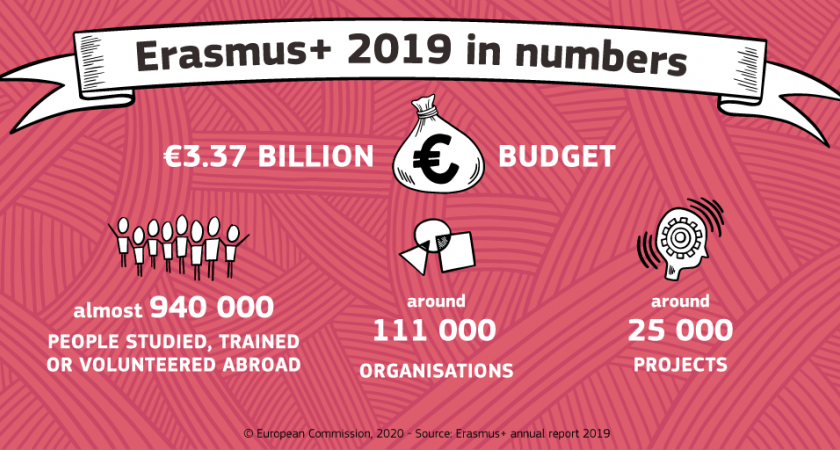- SERVICES
- HIGHER EDUCATION MARKETING
- ENGAGEMENT & ENROLLMENT MANAGEMENT
- STUDENT RECRUITMENT AGENCIES
- PROFESSIONAL EDUCATION & TRAINING
- WHO WE ARE
WHO WE ARE
Learn more about Keystone Education Group, including our leadership structure, why choose Keystone as your educational partner, and company press releases.
QUICK LINKS
- RESOURCES
RESOURCES
Find a range of helpful resources to help with your educational marketing. From on-demand webinars, reports & data, to customer testimonials and our downloadable media kit.
QUICK LINKS
- NEWS
- REQUEST A CALL

- Keystone Higher Education News
- The Future of the Erasmus+ Programme
 More than 10 million people have participated in Erasmus+ (and its predecessors) over the past three decades. The European Union's flagship program designed to support and strengthen intracontinental education, training, youth and sports, Erasmus+´s membership comprises all 28 U member states. This also includes the EEA and EFTA countries of Iceland, Liechtenstein and Norway, as well as North Macedonia and Turkey.
More than 10 million people have participated in Erasmus+ (and its predecessors) over the past three decades. The European Union's flagship program designed to support and strengthen intracontinental education, training, youth and sports, Erasmus+´s membership comprises all 28 U member states. This also includes the EEA and EFTA countries of Iceland, Liechtenstein and Norway, as well as North Macedonia and Turkey.
Erasmus+ has grown and evolved since its founding. With the most recent cycle coming to an end in 2020, it begs the question: what can we expect to see from Erasmus+ in the years ahead? Here’s a closer look at the future of this extraordinary mobility scheme.
The Evolution of Erasmus+
Erasmus began in 1987 as a higher education exchange program with 3,200 students from 11 countries participating that first year. Today, more than 300,000 students participate in Erasmus+ study and training programs every year.
The program underwent a significant transformation in 2014, expanding its reach to encompass additional projects. This includes more study abroad opportunities, traineeships, and apprenticeships for higher education, vocational education and training. It also merged with other programs to encompass sports, youth, volunteer and staff exchanges. The program’s name was changed to Erasmus+ to reflect these enhancements.
In its most recent cycle, Erasmus+’s €14.7 billion budget supported more than four million Europeans as they studied, trained, lived, and played abroad. An additional €1.68 billion was designated toward partner country funding.
The Aim of Erasmus+
The aim of Erasmus+ is to “contribute to the Europe 2020 strategy for growth, jobs, social equity and inclusion, as well as the aims of ET2020, the EU's strategic framework for education and training,” according to the programs website. Its areas of focus also include sustainable development in higher education, while supporting the objectives of the EU Youth Strategy. Specifically, its goals encompass:
The aim of Erasmus+ is to "contribute to the Europe 2020 strategy for growth, jobs, social equity and inclusion, as well as the aims of ET2020, the EU´s strategic framework for education and training "according to the program's website.
- Reducing unemployment; particularly among young people
- Promoting adult learning and the development of career-ready skills
- Encouraging youth to participate in European democracy
- Supporting innovation, cooperation and reform
- Reducing school dropouts
- Promoting mobility and cooperation between EU partner countries
The Impact of Erasmus+
Certainly, Erasmus+ has had a transformative impact on both mobility at large as well as on individual participants. Two recent studies underscore the impact Erasmus+ has had on the lives of millions of students; not just in terms of educational opportunities, but also regarding career prospects and overall quality of life.
In addition to helping with job placements, Erasmus+ experience is also linked with giving students and trainees new insights into their professional ambitions. The results are enhanced job opportunities, and career happiness. The program’s commitment to innovation is also associated with the development and strengthening of business skills; in particular, entrepeneurships.
The studies also demonstrate the role Erasmus+ plays in building “a sense of European identity and social cohesion.” A full 90 percent of Erasmus+ participants say the program improved their ability to work with people from different cultures, and also to feel more positive about the EU’s positioning in society. Erasmus+’s efforts to make its programs open to people from all backgrounds is also credited with fueling equality in education. In fact, just under two-thirds of universities report Erasmus+ projects boosted social inclusion and non-discimination on campus.
Erasmus+ programs are so beloved its alumni have come up with a term to describe adjusting to the experience’s conclusion: “Post-Erasmus Syndrome.” Indeed, students have an abundance of good things to say about Erasmus+. Romanian Geles Claudiu participated in three separate Erasmus exchanges in Italy; first as a student, then as an English teacher, and finally for work.
“They are one of the best experiences that I’ve ever had. Exchange is a good possibility and in my opinion, as many students as possible should do it. Although it is a big part of it, Erasmus is not only about education, but also about culture, languages and meeting other people. It is the point of European Union – getting to know other cultures,” said Claudiu.

What’s Next for Erasmus+
With the current Erasmus+ cycle set to conclude this year and a new one poised to run from 2021 to 2027, there’s a lot up in the air. Much of it is good news: the European Commission recently proposed doubling funding for the program to €30bn for the next seven-year cycle. Additionally, a movement is underway to make it easier for non-EU countries to participate in the program for a fee.
Claudiu also looked favorably on this prospect. “Although Erasmus was originally meant for Europe, it is good to extend it! Actually finally it is about globalization of the cultures. It is great to give someone from America or Asia a possibility to come to Europe and take a taste of it and vice versa,” he continued.
Moving forward, Erasmus+ is expected to continue to prioritize improving access to diverse learning schemes for young people with fewer opportunities toward the elimination of economic, social and cultural barriers. In addition to educational opportunities, Erasmus+ will also help young people acquire the credentials, skills and competencies they need to get jobs, start businesses, and become contributors to the European economy.
The pandemic is also expected to impact the future of Erasmus+ with flexibility, adaptability and innovation emerging as key areas. With travel limited by COVID-19, there’s been a shift toward blended mobility programs which have allowed participants to combine virtual learning, with help from digitization projects like the Erasmus app, with plans to go abroad when it’s possible. Despite the decreased mobility temporarily necessitated by the crisis, insiders say there’s still a huge amount of interest in the physical exchange programs for which Erasmus+ has long been known.
No discussion of the future of Erasmus+ is complete without mention of the question of the UK’s ongoing participation following the Brexit transition period. Since the official Brexit-deal between the UK and the EU was announced on Christmas Eve last year, it has become clear that the UK will not continue to take part in the program. instead they have plans to establish their own "Turing-Scheme" as a replacement for Erasmus+.
A landmark mobility initiative, Erasmus+ has had a profound impact on the lives of millions of people. As one cycle ends and another prepares to commence, countless others stand to benefit from its groundbreaking programs.
More about:
Related Tags
Just For You
Top Picks
Higher Ed Chats Podcast
Listen to the latest episodes of our Higher Ed Chats Podcast. Hear from Higher Ed thought-leaders from around the world!
The Keystone Awards 2026:
Nominate your institution or a student

Recognize your your university, team, colleagues and students for a Keystone Award!
Subscribe
to get the latest news and updates


